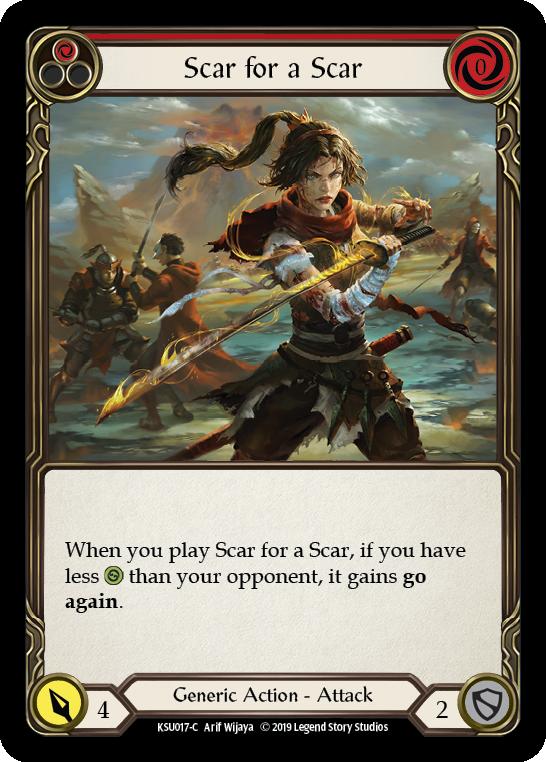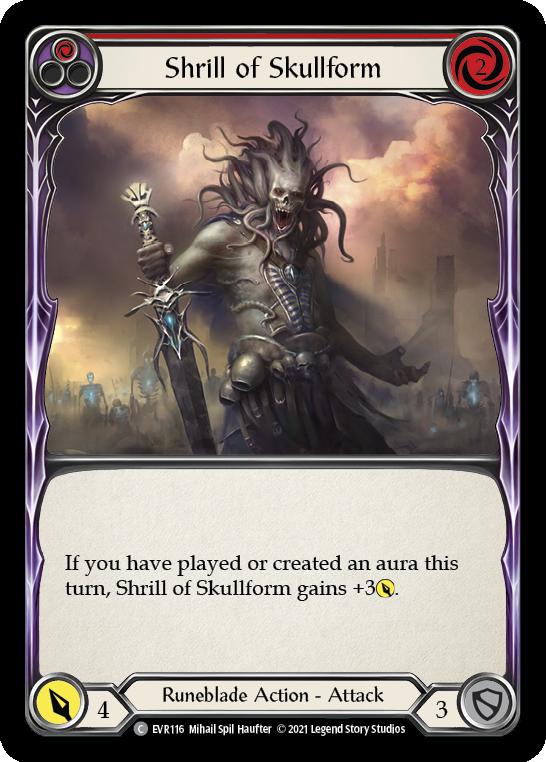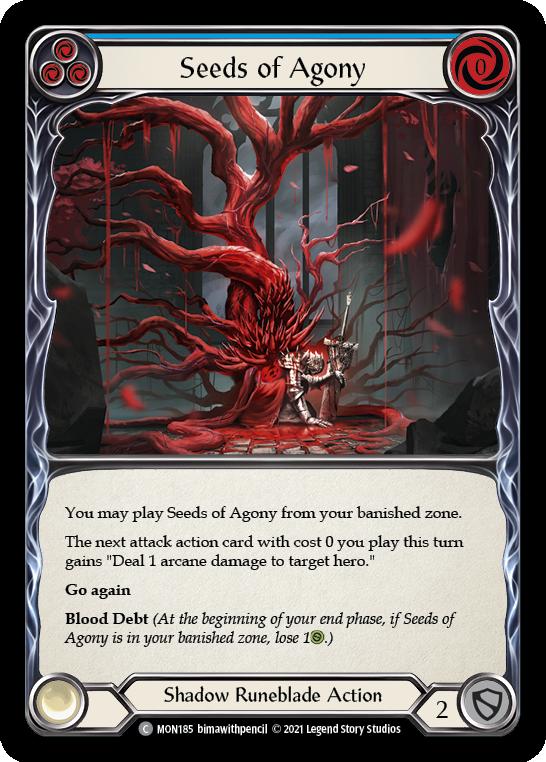Shadow Runeblade in Commoner – Part 1: The Chane Gang

Hello, and welcome back to my continuing series exploring the various metagame players and off-the-wall heroes in Commoner. I’ve been on a slight Talishar kick lately, playing as many games of Commoner on there as I can find, and have been extremely impressed by how well the Shadow Runeblades felt and played. Of course, Chane is already a known quantity within the Commoner metagame, but Vynnset was a very pleasant surprise at what she was capable of doing with the card pool available.
As such, these upcoming articles will focus on the Shadow Runeblades, starting with Chane, then Vynnset, and then finally, an overview on the differences and tenets of deckbuilding for them, as they have some surprising diverging choices.
When Stubby Hammerers was banned in Commoner, no deck felt its impact more than Chane. It reduced the potential damage output of the deck severely, in particular its ability to close out games. Withstanding already the Belittle ban in announcements prior, Chane is miraculously still a real contender in the Commoner metagame, being able to still play cards that are banned in other formats.
Let’s take a look at the list I’ve built. I haven’t included the Arcane Barrier options, but a mixture of Darkness equipment from Dusk Till Dawn and a piece of Nullrune should be enough for this deck and how well it can support paying for Arcane Barrier.
" The Chane Gang by Daniel Yam"
Some quick notes: this decklist was initially inspired by some of the Blitz Chane decks that were popular amongst top players locally in Skirmish season. A lot of the numbers and ratios are taken directly from that, adjusted for the Commoner card pool and metagame, most notably within the blue lineup. As a rule of thumb, the general ideal play pattern is to activate Chane for a Soul Shackle, play a non-attack action that would ideally pump up the next attack, send over an enhanced attack with go again off the Shackle, and then come in with Rosetta Thorn for four mixed damage. Chane is incredibly flexible, and the order of this can wildly vary depending on the banish zone, amount of material available, as well as cards left in deck. Typically I wouldn’t go beyond four Soul Shackles, and only really create the fifth one when I desperately need the go again.
The Best Equipment for Chane
Shadow Runeblades are genuinely blessed when it comes to their gear selection, pulling from the powerful versatile options that Shadow offers. With the ban of Hammerers, there are very few real contenders for its replacement; cards such as Cracker Jax and Bracers of Belief are extremely low value for what equipment can offer you these days, and Goliath Gauntlet belongs in a different type of deck entirely. I’ve opted for Grasp of Darkness simply due to how it can help prevent arcane damage. In a deck where you’re trying to leverage having so many extra cards per turn with the banished zone, any amount of defense provided by the equipment is amazing.
Shadow also opens up the option for Ebon Fold, which allows for what is functionally a free card – a fantastic option for cycling away the first play-from-banish card and setting up powerful turns at instant speed. Crown of Dichotomy is also well worth considering, since it sets up the top two cards of the deck to be banished by Soul Shackles, but I think that’s too slow, and the turns where you find yourself activating it are the games where you’re already severely disadvantaged. As for Snapdragon Scalers, I’ve opted for these over Sutcliffe’s Suede Hides simply due to the fact that it hits on almost every single attack in the deck except for the Shrills and Rifted Torment, which can be given go again with Chane’s ability anyway. Every potential resource that can be saved to play attacks is much more valuable to me than the corner case scenarios where the Suede Hides would be better.
Banish Zone
Of the 40 cards in the deck, half of them can be played from the banished zone. While I would have wanted perhaps slightly more redundancy in this department, a lot of the remaining attacks that can be played from banish are not particularly great on rate or cost. I’m already not thrilled to play Rifted Torment, and the remaining offerings of Piercing Shadow Vise and Rip Through Reality are less than stellar. Perhaps when the card pool allows for easier Runechant production that is generically good enough to play without disrupting the core game plan of the deck (think more Mauvrion Skies-type cards and less Read the Runes) that Vise is just better. But in its current iteration I’m extremely high on effects that can do mixed damage by itself.
While Seeds of Agony is an outrageous card, the blue copies only really hit off of Bounding Demigon and Scar for a Scar, and I recommend cutting a copy depending on where your personal preferences are regarding the other zero-cost attacks.
Non-Attack Actions for Chane
Rosetta Thorn inherently pulls us towards wanting to play a mixture of attacks and non-attack actions, and here I’ve gone about as light as possible on the various pump effects, heavily prioritizing cost efficiency. Much like how Warrior reactions on average represent three damage per card, I’ve gone a step further and only included the zero-cost Beseech the Demigon and Nimblism. Runic Reaping is the only exception to this, functioning as a poor man’s Mauvrion Skies, but doing the imitation well enough that I have no issue finding the space for it within the list, even if there are a few non-synergistic attacks in the deck, namely Ghostly Visit and Scar for a Scar.
You may be wondering why I’m not playing attack reactions such as Razor Reflexes or even an errant Pummel as was popular during the early days of the format. That all comes down to personal preference. Having access to the banished zone as a second hand comes at the minor cost of having to maximize on cards that can be played from it, and the remaining attacks have to be extremely high on rate to justify being played. An attack like red Shrill is exceptional when the activation of Chane to create the Shackle turns it into a seven-strength attack with go again, and cards such as Scar for a Scar have enough synergy with the deck between not wanting to block and blood debt that it should be enabled a good amount of the time.
Odds and Ends
The remaining parts of the deck are nothing particularly new or innovative. I prioritized blues that blocked for three and could be played from banish, doubling up on Bounding Demigon, Ghostly Visit, Rift Bind, and a few attacks that are good enough even at blue that it wouldn’t be entirely embarrassing needing to attack with them.
The blue Shrill is quite serviceable late game as a five-strength attack, and the Arcanic Crackles and Singeing Steelblade, while potentially the strangest deviation from a “stock list,” are a callback to the Blitz Chane decks that would oftentimes use the last few slots for a few cards with reach to crawl across the finish line. While Vexing Malice isn’t legal in Commoner, the one arcane damage on attack, if not game winning, will force opponents into awkward situations of committing two cards to fully block out these blue attacks.
Concluding Thoughts on Chane
While Chane is arguably too strong, or at the very least an unfun play experience, I absolute love the way the hero plays. Having a playstyle which doesn’t actually need to maintain chain links means that you can choose to activate his ability at different points in the turn depending on the texture of the hand and game state. The banish zone acting as a second hand in terms of card selection and being able to skew the deck towards taking as much advantage of that as possible is an extremely fun exercise in deckbuilding and really makes one think they’re a genius when it actually works.
Next time, I’ll be going over Vynnset, her strange deckbuilding needs, and why I actually think she’s a hero that could work very well in Commoner alongside Chane.
Further Reading:
Best Cards for Commoner in 2023

























